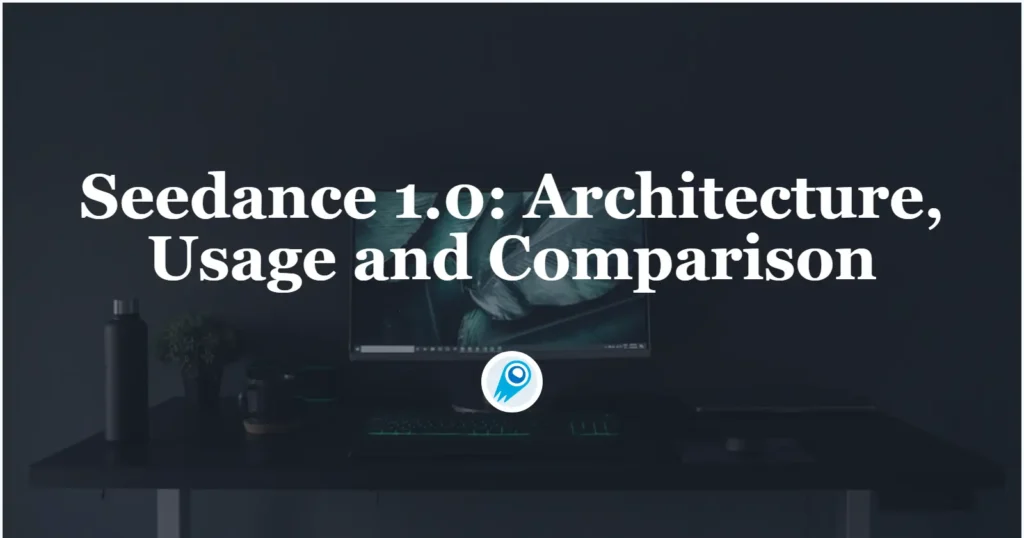Seedance 1.0: Architecture, Usage and Comparison

Seedance 1.0 marks a watershed moment in AI‑driven content creation, blending state‑of‑the‑art video generation with multi‑modal inputs. Since its unveiling by ByteDance’s Seed team on June 11, 2025, industry watchers have hailed it as a new benchmark for quality, speed, and cost‑effectiveness.
What Is Seedance 1.0 and Why Does It Matter?
Seedance 1.0 is ByteDance’s first-generation video foundation model designed to generate high‑definition videos from text and image prompts. Officially released on June 11, 2025, by the Volcano Engine team, Seedance 1.0 supports both text‑to‑video (T2V) and image‑to‑video (I2V) tasks in a unified architecture, enabling seamless transitions between different modalities without the need for separate pipelines . Unlike many prior diffusion‑based video models that treat multi‑shot narrative coherence as an afterthought, Seedance 1.0 natively supports multi‑shot storytelling, automatically generating 10‑second videos with 2–3 shot transitions that maintain subject consistency and cinematic flair .
In addition to its novel narrative capabilities, Seedance 1.0 boasts fast, cost‑effective inference. Leveraging a carefully optimized model architecture and system‑level acceleration, it can produce a 5‑second, 1080p video in 41.4 seconds on an NVIDIA L20 GPU—around 10× faster than comparable models—making it viable for real‑time content creation and rapid iteration workflows . Third‑party benchmarkers on platforms such as Artificial Analysis have ranked Seedance 1.0 at the top of both T2V and I2V leaderboards, underlining its breakthrough performance across prompt following, motion stability, and visual naturalness.
How does Seedance 1.0 work?
The Text‑to‑Video Pipeline
- Prompt Encoding: User‑provided text is parsed into semantic embeddings using a specialized language encoder fine‑tuned on narrative datasets.
- Scene Layout Generation: A layout generator proposes shot-by‑shot storyboards, outlining framing, camera movement, and scene transitions.
- Frame Synthesis: Diffusion networks render each frame at 1080p, incorporating motion priors to ensure temporal coherence.
- Multi‑Shot Composition: A shot selection module seamlessly stitches together the synthesized frames into a continuous video, adjusting cuts and transitions automatically ([字节跳动 Seed][1]).
The Image‑to‑Video Pipeline
- Source Image Analysis: Uploaded images are analyzed for structure, texture, and semantics.
- Motion Vector Field Estimation: The model infers plausible motion trajectories (e.g., panning, zooming, object movement).
- Animation Rendering: Frames are interpolated between the original image and target “poses,” creating the illusion of camera movement or dynamic action.
- Style Transfer & Refinement: A final style network harmonizes tone, color, and lighting to match the user’s specified aesthetic or reference examples .
What System‑Level Optimizations Enable Fast Inference?
Beyond architectural design, Seedance 1.0 incorporates specialized techniques to accelerate video generation:
- Multi‑Stage Distillation: Larger, slower teacher models guide distilled student models, retaining quality while significantly reducing parameters and FLOPs.
- Inference Fusion and Caching: Reuse of intermediate feature maps across adjacent frames minimizes redundant computation, particularly effective in scenes with subtle motion.
- GPU‑Specific Kernels: Hand‑tuned CUDA kernels further speed up key operations such as 3D convolution and cross‑attention, leveraging the NVIDIA L20’s Tensor cores for maximum throughput .
Collectively, these optimizations allow Seedance 1.0 to generate a 5‑second 1080p video in just 41.4 seconds, a speedup of roughly 10× compared to earlier state‑of‑the‑art models.
What Distinguishes Seedance 1.0 Pro from Seedance 1.0 Lite?
How Do the Pro and Lite Variants Compare?
Seedance 1.0 ships in two variants—Pro and Lite—tailored to different user needs:
| Feature | Seedance 1.0 Pro | Seedance 1.0 Lite |
|---|---|---|
| Maximum Resolution | 1080p | 480p / 720p |
| Typical Inference Time (5s) | 41.4 seconds (NVIDIA L20) | ~20 seconds (NVIDIA L20) |
| Target Use Cases | Cinematic shorts, branded content | Social media posts, e‑commerce ads |
| API Availability | Enterprise‑grade with high throughput | Publicly accessible via CometAPI platform |
| Price Point | Premium subscription / custom licensing | Affordable per‑minute billing |
Seedance 1.0 Pro emphasizes maximum quality and resolution, catering to professional filmmakers and enterprises seeking cinematic output. Conversely, Seedance 1.0 Lite prioritizes speed and cost‑efficiency, making it ideal for rapid content creation in marketing, social media, and preliminary storyboarding .
How can users access and use Seedance 1.0?
Getting Started via ByteDance
- Account Setup: Visit the official Seedance portal and register or log in with a ByteDance ID.
- Model Selection: Choose between the full Seedance 1.0 model or the lightweight Seedance Lite, which offers faster previews at slightly reduced quality.
- Input Configuration: Enter a descriptive text prompt (e.g., “A futuristic cityscape at sunrise, panning from skyscraper to street level”) or upload up to three reference images.
- Parameter Tuning: Adjust duration (5–30 seconds), camera style (fixed, dolly, pan), and creative constraints (color palette, cinematic filters).
- Generate & Review: Submit the job; in under 20 seconds you’ll receive a download link for your 1080p video clip.
Getting Started via CometAPI
Sign up / Log in: Go to cometapi.com and register (or log in).
Create an API Token:In your dashboard, open “Tokens” → “Add Token” → give it a name → copy the generated key (e.g. sk-xxxx) .
Get the URL from doc, such as video generation:
posthttps://api.cometapi.com/volc/v3/contents/generations/tasksPlayground & API Docs:
- Playground: Experiment interactively at CometAPI’s AI Playground before coding.
- Full Reference: See detailed parameters, error codes, and examples in the API guide.
Best Practices and Tips
Detailed Prompts: The more specific your text (including adjectives, moods, and camera directives), the closer the output matches your vision.
Reference Images: For stylized or branded looks, supply high‑resolution images showcasing lighting, texture, and composition.
Detailed Prompts: Include adjectives, camera movement, shot type (e.g., “wide shot,” “dolly in”).
Reference Images: For image-to-video, upload up to three high-res images in your request.
Iterate Quickly: Use the Lite variant (seedance-1-0-lite) for fast proofs of concept, then switch to Pro for final renders.
Quota Alerts: In the CometAPI dashboard, set up usage and cost alerts so you never overspend.
Is Seedance 1.0 Better Than Google Veo 3?
Benchmarks Comparison
A key question in the AI community is whether Seedance 1.0 surpasses Google Veo 3, Google’s state‑of‑the‑art video generation model. Multiple industry benchmarks provide a clear answer:
- Artificial Analysis T2V & I2V Leaderboards: Seedance 1.0 Pro holds first place in both T2V and I2V categories, whereas Google Veo 3 ranks second in both evaluations.
- SeedVideoBench‑1.0: On a proprietary test suite of 300 prompts, Seedance 1.0 demonstrates superior prompt fidelity and motion fluidity, scoring an average of 4.7/5 versus Veo 3’s 4.3/5 .
- Third‑Party Human Evaluations: In blind studies conducted by AIbase, human raters preferred Seedance 1.0 outputs 62% of the time over Veo 3, citing better shot transitions and more coherent storytelling .
What Advantages Does Seedance 1.0 Offer Over Veo 3?
Native Multi‑Shot Storytelling: Veo 3 typically requires manual prompts to switch camera angles or framing. Seedance 1.0’s built‑in shot segmentation automates this process, yielding more cinematic narratives without extra user effort.
Inference Efficiency: While Veo 3 can generate a 5‑second 720p video in approximately 70 seconds on comparable hardware, Seedance 1.0 Pro’s system‑level optimizations halve that time, making it more practical for tight production schedules.
Instruction Following in Complex Scenes: Seedance 1.0’s RLHF fine‑tuning and nuanced reward mechanisms lead to higher accuracy in multi‑subject contexts (e.g., “two dancers performing in sync”), where Veo 3 occasionally loses track of secondary subjects.
What Are the Leading Applications of Seedance 1.0?
How Are Content Creators Leveraging the Model?
- Social Media Marketing: Brands use Seedance 1.0 Lite to produce eye‑catching 10‑second ads at a fraction of traditional production costs, driving higher engagement on platforms like TikTok and Instagram .
- E‑Commerce Product Videos: Retailers generate quick clip showcases of apparel or gadgets directly from product images, enabling rapid A/B testing of visual campaigns without manual video shoots .
- Film Pre‑Visualization: Indie filmmakers and storyboard artists employ Seedance 1.0 Pro to prototype scene compositions and camera movements, streamlining the planning phase of production .
- Educational Content: E‑learning platforms create animated explainer videos from text scripts, making complex topics more engaging through dynamic visuals and contextual shot transitions .
What Enterprise Use Cases Are Emerging?
- Corporate Training: Automated creation of standardized training videos with consistent branding and messaging, reducing reliance on external video production agencies .
- Virtual Events and Webinars: Generating promotional teasers and interstitials for live online events, enhancing professional polish without heavy post‑production.
- Advertising Agencies: Rapid iteration of campaign concepts, allowing creative teams to test multiple narrative angles before committing to full video shoots .
What Are the Limitations?
Despite its impressive performance, Seedance 1.0 exhibits some limitations:
- Long‑Form Consistency: While multi‑shot transitions are strong in 10‑second clips, generating coherent narratives beyond 15 seconds can lead to temporal drift and subject inconsistency .
- High‑Resolution Generation: Seedance 1.0 Pro tops out at 1080p; professional film production often demands 4K or higher resolutions, an area where competitors are beginning to push.
- Complex Scene Understanding: In scenes with intricate interactions (e.g., “crowd of people dancing in a flash mob”), the model occasionally omits or distorts secondary participants, indicating room for improved multi‑subject modeling.
Getting Started
CometAPI provides a unified REST interface that aggregates hundreds of AI models—including ChatGPT family—under a consistent endpoint, with built-in API-key management, usage quotas, and billing dashboards. Instead of juggling multiple vendor URLs and credentials.
Developers can access Seedance 1.0 Pro and Seedance 1.0 Lite through CometAPI, the latest models version listed are as of the article’s publication date. To begin, explore the model’s capabilities in the Playground and consult the API guide for detailed instructions. Before accessing, please make sure you have logged in to CometAPI and obtained the API key. CometAPI offer a price far lower than the official price to help you integrate.
Conclusion
Seedance 1.0 represents a major leap forward in AI‑driven video generation. By unifying T2V and I2V capabilities, natively supporting multi‑shot storytelling, and delivering industry‑leading inference speeds, it has set new benchmarks that outpace even Google Veo 3 in both quality and efficiency. The availability of both Pro and Lite variants ensures that creators—from indie filmmakers to social media marketers—can leverage state‑of‑the‑art generative video technology within their budget and technical constraints. While challenges remain in long‑form consistency and ultra‑high‑resolution output, ByteDance’s aggressive roadmap promises continuous improvements. As Seedance evolves, it is poised to redefine not just how videos are made, but who can make them—and that promises to reshape the future of visual storytelling.

